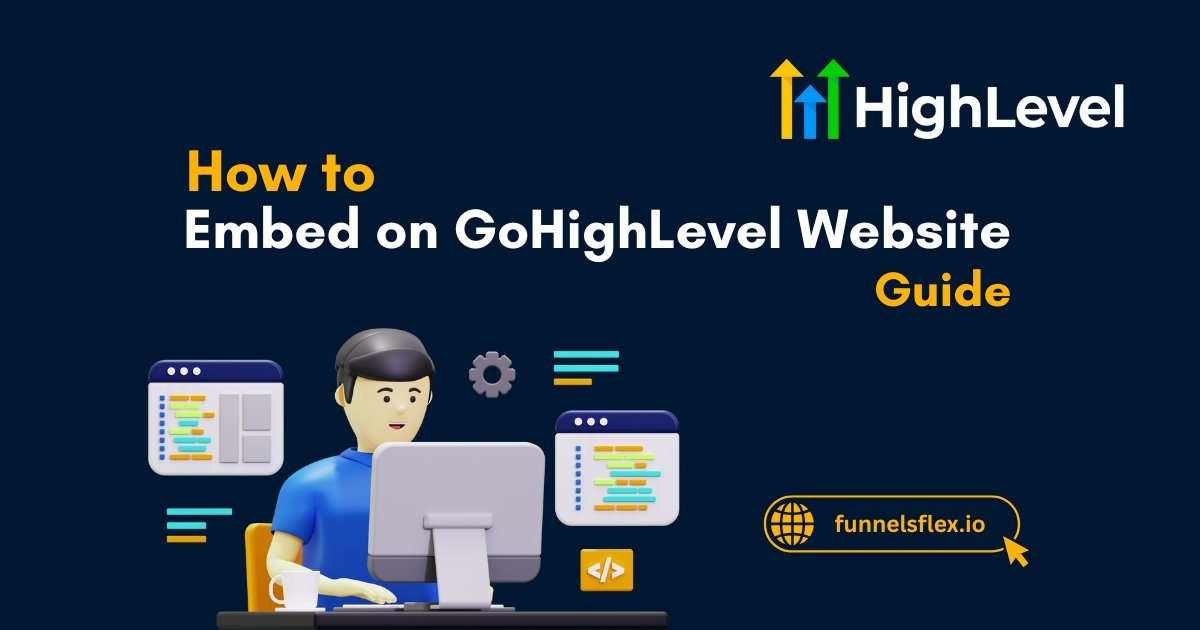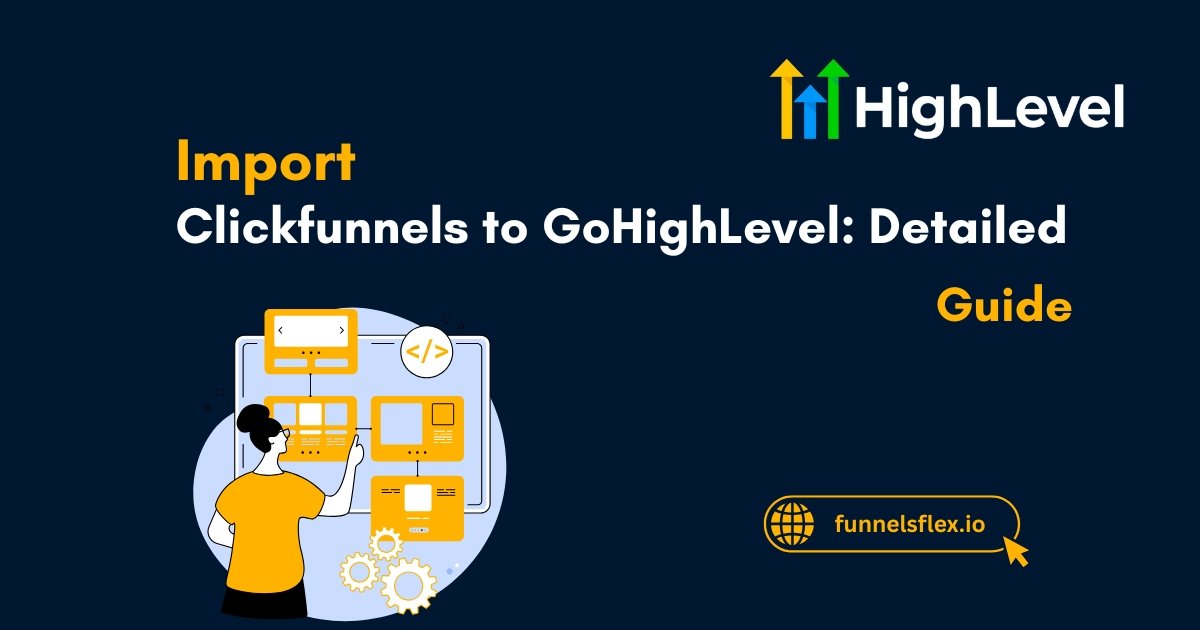How to Embed on GoHighLevel Website: Detailed Guide 2025
This guide will answer how to embed on GoHighLevel website. Embedding content into your site is more than just a technical step. It is your sales hub, lead machine, and client magnet.
Think of it like giving your website extra powers. You are not just pasting code. You are opening the door to live calendars, smart forms, videos, and interactive features that make your page do more than just sit there.
This comprehensive post will discuss how to embed just about anything on your HighLevel website.
Key Takeaways
Want to save time? Shop our custom GoHighLevel funnel templates.
Understanding Embedding in GoHighLevel
Before answering how to embed on GoHighLevel website, it is important to get a solid grasp of what embedding means.
In simple terms, embedding helps you display content or features on your website that come from other platforms or parts of GoHighLevel. Instead of redirecting users somewhere else, you keep them engaged on your page.
GoHighLevel gives you various embed codes, mainly in HTML or iframe formats. Once you paste this code into your page, the content becomes visible to visitors.
The goal is to make your website more user-friendly and conversion-focused by integrating booking calendars, lead capture forms, surveys, videos, and even entire dashboards.
Read this: Does GoHighLevel Host Websites? Everything You Need to Know
How Embedding Works Inside GoHighLevel Website
When you embed features directly into your website, you reduce friction. Visitors do not need to leave the page to complete actions like filling out a form or scheduling an appointment. Everything happens in one place.
Embedding also gives you more flexibility. You can mix and match GoHighLevel features with third-party apps like YouTube, Google Forms, Calendly, or live chat tools.
Embedding a Form on Your GoHighLevel Website
Forms in GoHighLevel help you capture leads, collect information, or onboard new clients. They are fully customizable and can be used across funnels, landing pages, or websites.

Access Your Form
Log in to your GoHighLevel dashboard. Navigate to the Sites tab, then click Forms. Select the form you want to embed or create a new one.
Copy the Embed Code
Once the form opens, go to the Integrate tab. You will see the embed code provided in HTML format. Copy it to your clipboard.
Open Your Website Editor
In the same dashboard, click on Sites, then choose the Funnel or Website where you want to place the form. Select the page and click Edit Page.
Add a Code Element
Within the editor, find the section where you want the form to appear. Click + Add Element, then drag and drop the Custom Code element to that section.
Paste the Embed Code
Click on the code box and paste the form code you copied earlier. Click Save in the top-right corner to apply changes.
Preview and Publish
Click Preview to make sure the form displays properly. If everything is working fine, click Save and then Publish the page. Now your form is live on your GoHighLevel website, ready to collect leads or information.
Embedding a Calendar on Your GoHighLevel Website
GoHighLevel calendars make it easy for leads or clients to book appointments without needing back-and-forth messages.
By embedding your calendar directly on your website, you let visitors schedule calls, consultations, or services instantly.

Open the Calendar Settings
Log in to your GoHighLevel dashboard. Click on Calendars in the main menu. Choose the calendar you want to embed by clicking on its name.
Get the Embed Code
Click the three dots in the top-right corner of the calendar window. From the dropdown, select Share or Embed Code. Copy the HTML code that appears.
Navigate to Your Website Editor
Go to the Sites section. Pick the funnel or website where you want the calendar to appear. Click Edit Page to launch the editor.
Insert the Embed Code
Locate the section where you want the calendar. Click + Add Element, and drag the Custom Code element into place. Paste the embed code you copied from the calendar settings.
Save and Publish
Click Save to keep your changes. Use the Preview button to check how the calendar displays. Once confirmed, click Publish to make it live.
Visitors can now see your calendar, choose a time slot, and confirm their booking – all without leaving the page.
Need Done-For-You Funnels? Click here to shop templates built to perform.
Pro Tip
Before adding custom scripts or embed codes to your main funnel, test them on a cloned version under a subdomain like test.yoursite.com. This keeps your live pages clean while you troubleshoot layout or script conflicts.
Embedding Custom HTML on GoHighLevel Pages
Sometimes you need more than basic elements. Maybe you want to insert a countdown timer, a design block, or a third-party widget.
GoHighLevel supports custom HTML, which lets you add personalized or external content directly to your pages.
Prepare Your HTML Code
Write or get the HTML code you want to embed. This might come from a third-party tool like a timer app, chat widget, or an email opt-in form. If the code includes inline CSS or JavaScript, it can be used as is.
Open the Page Editor
From your GoHighLevel dashboard, click on Sites, then select Funnels or Websites. Pick the page where the HTML should go and click Edit Page.
Add the Custom Code Element
Scroll to the section where you want to embed the HTML. Click + Add Element, then drag in the Custom Code block. This is the container where you will paste your HTML.
Paste Your HTML Code
Click inside the code block and paste the HTML code. If it includes style tags or scripts, make sure everything is inside the same block. You do not need to add anything outside of what was provided.
Adjust Layout if Needed
To make the HTML content span the full width of the page, go to the section and row settings. Enable the full width option and remove any padding. This ensures that custom code looks aligned with the rest of your design.
Save and Test
Click Save, then Preview your page. Confirm the HTML content appears and functions correctly. If it looks good, go ahead and publish.
Read this: What Are Sales Funnels Used For? Must-Read Guide for Business Owners
Embedding External Tools Using Iframes
Iframes allow you to embed entire sections or tools from other platforms directly onto your GoHighLevel website.
This is useful for things like surveys, booking widgets, CRMs, or reporting dashboards that live outside GoHighLevel but are part of your workflow.
Get the Iframe Code from the Source
Visit the external platform where your tool or content is hosted. Most services that allow embedding – like Google Forms, Calendly, or Data Studio – offer iframe codes. Look for a share or embed option and copy the full iframe HTML.
Open Your Page in GoHighLevel
Return to your GoHighLevel dashboard. Click on Sites, choose your Website or Funnel, and then select the page where you want the embed. Click Edit Page to begin.
Insert a Custom Code Element
Scroll to the area where the embedded content should go. Click + Add Element, then choose the Custom Code option. Drag it into place inside your section or column.
Paste the Iframe Code
Click into the code box and paste the iframe code you copied earlier. Make sure the code includes height and width values so the element fits well on your page. You can adjust these later to improve spacing.
Save and Preview
Click Save, then use the Preview button to confirm the iframe content loads properly. If needed, adjust the height or width to fit your layout. Once satisfied, click Publish.
Embedding a YouTube Video on Your GoHighLevel Website
Videos increase engagement and help build trust. Adding a YouTube video to your GoHighLevel website lets you deliver your message clearly—through tutorials, testimonials, or product demos.
Find the Video on YouTube
Go to YouTube and open the video you want to embed. Click on the Share button located below the video. In the popup, choose Embed. You will see an iframe code generated by YouTube. Click Copy to copy the entire snippet.
Open the GoHighLevel Page Editor
From your dashboard, head over to the Sites section. Choose the funnel or website that should feature the video. Select the page and click Edit Page.
Add a Custom Code Block
Scroll to the spot where you want to place the video. Click + Add Element and drag in a Custom Code element. This will allow you to paste the iframe code into your layout.
Paste the Video Embed Code
Click inside the code box and paste the iframe code you copied from YouTube. The code will look something like <iframe src=”https://www.youtube.com/embed/yourvideoid”…></iframe>.
Preview and Make Live
Click Save, then check the Preview to see how the video looks. You can adjust the width and height directly in the iframe tag if needed. Once it displays correctly, click Publish.
Looking for a faster way to get things done? Get instant access to high-converting GoHighLevel funnel templates – customized for speed and results.
Pro Tip
If you are embedding external forms or CRMs, connect them with GoHighLevel using webhooks. This ensures real-time syncing of lead data across platforms without manual imports.
Embedding a Live Chat Widget on Your GoHighLevel Website
Adding a live chat widget to your GoHighLevel website gives visitors a direct way to ask questions, get support, or request a callback. Most chat tools provide an embed script that works perfectly with GoHighLevel.
Choose a Live Chat Provider
Pick a live chat platform that suits your needs. Tools like Tawk.to, Tidio, Intercom, and Crisp are popular choices. Sign in to your account on the chosen platform and locate the installation or embed code in the settings area.
Copy the Chat Widget Code
Once inside your chat dashboard, look for an option that says Install Widget, Embed Code, or Add to Website. You will see a JavaScript snippet provided for integration. Copy this entire script to your clipboard.
Access Page Settings in GoHighLevel
Go to your Sites tab in GoHighLevel. Choose the website or funnel you want to modify. Click on the specific page where the chat widget should appear.
Instead of adding a code block to the page layout, you will be pasting this code into the page settings.
Paste the Code into the Header or Body
Once the editor is open, click on Settings from the top menu. Scroll down to find Header Code or Body Code.
Based on your chat tool’s instructions, paste the script into the correct field. Usually, these codes go into the body section just before the closing tag.
Save and Test Functionality
Click Save and exit the editor. Open a live preview of the page. The chat widget should now appear in the lower corner of your website. Test it to confirm that it loads correctly and sends messages as expected.
Embedding Google Maps on Your GoHighLevel Website
If you run a location-based business or want to showcase your office, embedding Google Maps on your GoHighLevel website gives visitors a quick way to find you.
This is especially useful for service providers, local agencies, or businesses with physical locations.
Search Your Location on Google Maps
Go to Google Maps and type in your business name or address. Once your location appears, click on the Share button in the left panel. A popup will appear with two options—choose Embed a Map.
Copy the Iframe Code
After selecting the Embed tab, Google will generate an iframe code for your map. It includes the exact coordinates and zoom level. Choose the size (small, medium, large, or custom), then click Copy HTML.
Open Your GoHighLevel Page Editor
In your GoHighLevel dashboard, head over to the Sites section. Open the funnel or website where the map should appear. Select the desired page and click Edit Page to launch the builder.
Insert a Custom Code Block
Navigate to the part of the page where you want the map to go. Click + Add Element and drag in a Custom Code element. Click into the code field and paste the iframe code you copied from Google Maps.
Save and Adjust If Needed
Click Save to store your changes. Use the Preview button to view how the map appears on the live page. If needed, adjust the iframe’s width and height manually in the code to better fit your design.
Embedding a Survey or Quiz on Your GoHighLevel Website
Surveys and quizzes make your website interactive. They help you collect feedback, segment leads, or qualify prospects.
Copy the Embed Code from the Survey Tool
Go to your form builder—Typeform, Google Forms, or any quiz platform you use. Find the survey or quiz you created and locate the Embed or Share option. Choose the HTML embed version and copy the iframe code provided.
Open the Target Page in GoHighLevel
Log in to your GoHighLevel dashboard. Head to the Sites area and open the funnel or website where you want to place the survey. Select the right page and click Edit Page to start editing.
Add a Custom Code Block to Your Page
Scroll to the section where the survey should go. Click + Add Element, drag in a Custom Code block, and drop it into place. Paste the iframe code inside the box.
Test and Publish
Click Save, then Preview to make sure the survey or quiz displays correctly. Submit a test response to check functionality. Then click Publish.
Embedding a Facebook Pixel on Your GoHighLevel Website
Adding a Facebook Pixel to your GoHighLevel website allows you to track conversions, build retargeting audiences, and optimize ads for better results.
Create or Access Your Facebook Pixel
Log in to your Facebook Business Manager. Go to Events Manager, then select or create a new Pixel. Once created, click Set Up, then choose Install Code Manually. Facebook will generate a base Pixel code for your site.
Copy the Pixel Base Code
You will see a snippet of JavaScript. This is the core tracking code. Click Copy Code to save it to your clipboard. You will need this for the next step.
Open Your GoHighLevel Funnel or Website
Go to the Sites tab inside your GoHighLevel dashboard. Open the funnel or website where you want to track visitor activity. Choose the specific page or funnel step and click Edit Page.
Access Page Settings
At the top of the page editor, click on Settings. Scroll to find the Header Code section. Paste the copied code into the Header Code field. Do not modify it. Scroll down and click Save to apply the change.
Test the Pixel Installation
Install the Facebook Pixel Helper Chrome extension. Open your live GoHighLevel page in a new tab. The Pixel Helper will detect and confirm that the Pixel is firing correctly.
Pro Tip
Instead of adding several separate embed codes (e.g., analytics, chat, pixels), create one optimized JavaScript file and host it externally. Then embed just that one script, simplifying management and improving page speed.
Embedding a Countdown Timer on Your GoHighLevel Website
Countdown timers are powerful for creating urgency. You can use tools like CountdownMail, MotionMail, or Convertful to generate timer embed codes that work perfectly with GoHighLevel.
Choose and Set Up a Timer Tool
Start by selecting a countdown timer platform that provides HTML or iframe embed codes. Create your timer, set the deadline (either fixed or evergreen), choose the style, and generate the embed snippet.
Copy the Timer’s Embed Code
Once your countdown timer is ready, the platform will generate an HTML or iframe code. Make sure you select the responsive version if it is available. Copy this code to your clipboard.
Open the GoHighLevel Page Builder
Head to the Sites section in your GoHighLevel dashboard. Select the website or funnel where the countdown should appear. Open the desired page and click Edit Page to enter the builder.
Insert a Custom Code Element
Find the section where you want to place the timer. Click + Add Element, then drag in a Custom Code block. Paste the embed code into the field provided.
Save and Preview Your Page
Click Save to lock in the changes. Use Preview to view how the timer appears on the page. Test how it behaves – make sure it counts down correctly and looks good on all devices.
Your next funnel is just a click away. Get Custom Funnel Templates Now and start converting today.
Embedding an External Dashboard on Your GoHighLevel Website
Embedding an external dashboard inside GoHighLevel is ideal when you need to display client reports, campaign data, or performance metrics from tools like Google Data Studio or AgencyAnalytics.
Generate the Dashboard Embed Link
Go to the external platform where your dashboard is hosted. Find the dashboard you want to embed. Look for a Share, Publish, or Embed option.
Make sure public access or embed permissions are turned on. Copy the iframe code or shareable link provided.
Open Your GoHighLevel Dashboard Area
From your GoHighLevel account, navigate to the Dashboards section. Select the workspace or sub-account where you want the external dashboard to appear.
Click the Pencil Icon to Edit
In the dashboard view, find the pencil or Edit Dashboard icon at the top-right corner of the screen. This opens the layout editor and allows you to add widgets or content blocks.
Add a New Embed Widget
Click + Add Widget, then select Elements from the available options. Choose the Embed element from the list. This widget is designed to display iframe or link-based content inside the GoHighLevel dashboard.
Paste the Link or Embed Code
In the settings panel of the new widget, paste the iframe code or shareable URL from your external dashboard. You can also give it a title like “Client Reports” or “Marketing Analytics.” Adjust the width and height if needed.
Save and View the Embedded Dashboard
Click Save to update your changes. The external dashboard will now appear within your GoHighLevel dashboard layout. You and your clients can view it directly without leaving the platform.
Embedding a Payment Checkout Page on Your GoHighLevel Website
Embedding a payment checkout page allows you to accept payments directly from your GoHighLevel website. Tools like Stripe, PayPal, or ThriveCart offer secure, embeddable checkout forms.
Set Up Your Checkout Page
First, log in to your payment platform. Create your product, set the pricing, and build your checkout form.
Once finalized, head to the platform’s share or embed settings. Look for an option that provides HTML or iframe code for website integration.
Copy the Embed or Checkout Code
Once your checkout form is ready, the tool will generate a script or iframe code.
Some platforms (like ThriveCart or SamCart) offer embeddable checkout forms, while others (like PayPal or Stripe) give you a hosted payment link.
If it is a link, use a button; if it is a code, use the embed.
Open Your GoHighLevel Funnel or Website Editor
Inside your GoHighLevel dashboard, go to Sites and pick the funnel or website where the checkout will appear. Select the page and click Edit Page.
Insert the Code or Link
If you have an embed code, drag a Custom Code block into the section where the checkout should appear. Paste the code there.
If you are using a hosted link, use a Button Element, set the link type to URL, and paste the checkout link.
Save Your Checkout Page
Click Save, then Preview your page. Confirm that the checkout form appears and processes transactions correctly.
Embedding Custom JavaScript Function on Your GoHighLevel Website
Sometimes, you need more advanced functionality on your GoHighLevel site – like animations, tracking triggers, pop-ups, or third-party integrations.
Embedding a custom JavaScript function allows you to add dynamic behavior that cannot be achieved through basic settings or HTML alone.
Write or Obtain Your JavaScript Code
Start with a script that performs a specific function. This might be something you created – like a scroll animation – or a third-party code snippet from tools like Cookie Consent, or LiveCall.
Make sure the code is clean, and tested, and does not conflict with other elements on the page.
Go to the GoHighLevel Page or Funnel
Inside your GoHighLevel dashboard, head over to Sites, then choose the funnel or website where you want to add the script. Select the page and click Edit Page.
Open Page Settings
In the page builder, click Settings at the top. This will show you fields for Header Code and Body Code. These sections allow you to embed scripts that load on the page without needing visual blocks.
Paste the JavaScript in the Appropriate Field
If the JavaScript code runs on page load or sets up listeners, place it in the Header Code.
If it interacts with content after load like form submissions, paste it in the Body Code section. Wrap raw JavaScript inside <script> tags if it is not already formatted.
Save and Preview the Page
Click Save, then click Preview to see the script in action. Test its functionality across different devices and browsers. If everything runs correctly and there are no errors, publish the page.
Ready to launch? Explore our professionally made funnel template and go live in minutes.
Frequently Asked Questions








